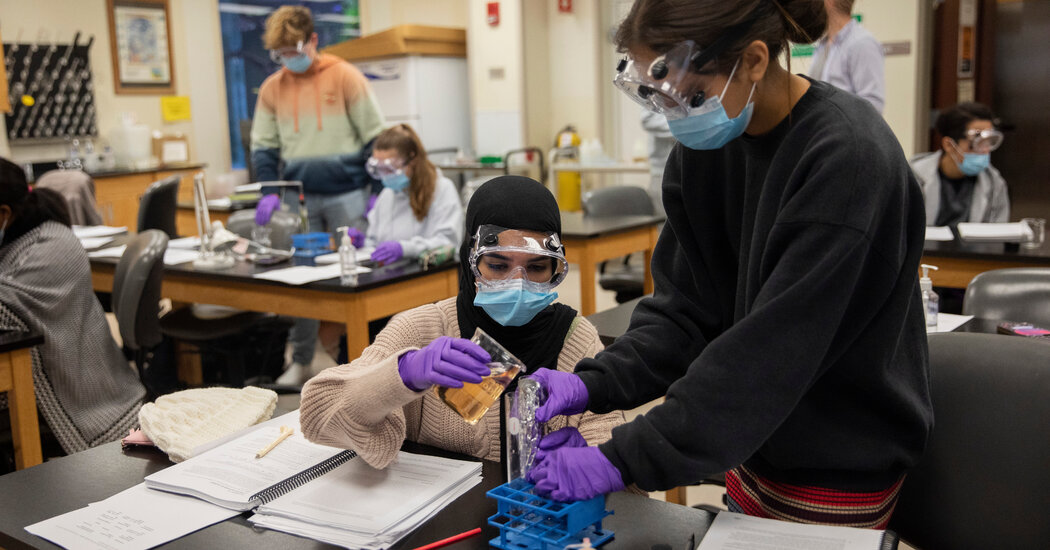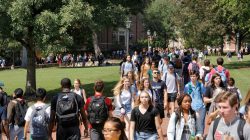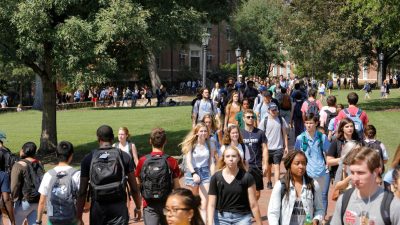To hear more audio stories from publications like The New York Times, download Audm for iPhone or Android.
Jazeba Ahmad was a junior in high school when Covid-19 hit and her math education faltered. Ms. Ahmad was enrolled in an international baccalaureate math class intended to provide a strong foundation in areas like algebra, geometry, statistics and calculus.
But her high school in Columbus, Ohio, made a rocky transition to remote learning, she said, and soon, math classes passed with little to show for them. By her first year at Columbus State Community College, Ms. Ahmad, 19, found herself floundering in something that should have been mastered — algebra.
“I missed out a lot in those two years,” Ms. Ahmad said. “If I had learned those skills in high school, I feel like I would have been better equipped to do well in that class.”
Colleges are now educating their first waves of students who experienced pandemic learning loss in high school. What they are seeing is sobering, especially because the latest dismal results from the national exam of fourth and eighth graders suggest that they could face year after year of incoming students struggling to catch up. In almost all states, there were significant declines in eighth-grade math, and most states also showed a dip in reading for fourth and eighth graders.
In interviews across the country, undergraduates discussed how their disjointed high school experiences have trailed them in their first years of college; some professors talked about how grades are down, as well as standards. Many students are tentative and anxious.
For many low-income students and students of color, who have historically faced bigger obstacles to earning a degree, classes seem to be that much harder and graduating that much tougher.
As it is, in many states, high school graduation rates fell for the class of 2021. And undergraduate enrollment has declined 4.2 percent since 2020, according to preliminary data published recently by the National Student Clearinghouse Research Center.
The swirl of issues “all demonstrate that we’ve got a crisis,” said Stanley Litow, a visiting professor of public policy at Duke University and a former deputy chancellor of the New York City public schools.
More on America’s College Campuses
It’s especially bad, he said, for low-income students and students of color. “The population that we’re most interested in doing the most for seems to be moving in the wrong direction,” he said.
Benedict College, a historically Black college in Columbia, S.C., is facing that reality. First-year enrollment there, which typically hovers around 700 students, was halved in the fall of 2020 and rebounded to just under 600 last fall, said the college president, Roslyn Clark Artis. But this term, administrators were stunned to see an enrollment of just 378, which Dr. Artis attributed to students’ concerns about the economy.
Most students were high school sophomores when Covid hit, and they arrived with lower ACT scores than in previous years. The college has seen “significant remediation needs” in math, Dr. Artis said.
“We are now two and a half weeks past midterm, and our grades are telling the tale: students are struggling in math,” she said.
In math departments across the country, professors and administrators say more students need more support. Professors talked of whittling their syllabuses and lowering their expectations.
Lee DeVille, a math professor at the University of Illinois at Urbana-Champaign, said he “triaged” a class this past spring to focus on fundamentals. It pained him, he said, to cut out some “beautiful mathematics,” but it seemed necessary.
“They came in with a little bit less, and they probably came out with a little bit less,” he said.
At Texas A&M University, some math classes saw higher rates of D’s and F’s, as well as more withdrawals, over the course of the pandemic. The problems have been particularly bad for first-year students, said Paulo Lima-Filho, the executive director of the university’s math learning center, which provides tutoring.
Students of all kinds seemed to lack sharp foundational math skills and rigorous study habits, he said. And some students had flawed understandings of basic concepts, which particularly worried him.
“That gap will propagate through the generation of the cohort,” Dr. Lima-Filho said. “Colleges are going to have to make an extra effort to bridge that gap.”
Nick Sullivan, a sophomore at A&M, took a hybrid calculus course at his high school in Belton, Texas. Students learned primarily from videos, with supplementary in-person instruction, a style that “did not work at all for me,” he said.
Still, Mr. Sullivan had hoped last year that the class would give him an advantage in college calculus. But he found that nearly nothing carried over, he said, and that “I actually thought the wrong things.”
An engaging professor and help from the math center have helped him make up for the lost time, he said, and he is now majoring in nuclear engineering.
In college writing and literature courses, instructors say they have seen fewer issues with student readiness. But many pointed to other concerns, including higher levels of anxiety and a reduced willingness to find support.
At Auburn University’s writing center, first-year students historically made up about 30 percent of those seeking help — “the single biggest constituency that we’ve served,” said Christopher Basgier, the director of university writing.
That has dropped to 20 percent. “It may be that because they spent more time learning from home, they aren’t used to going out and seeking that kind of extra help,” he said.
The big risk for students is taking more time, and perhaps more money, on earning a degree — or not getting one at all.
At Benedict, which serves many low-income, first-generation students, the pandemic has made it even harder to ensure that students graduate on time, Dr. Artis said. The college’s six-year graduation rate in 2021-22 stood at 25 percent, according to data from the U.S. Department of Education.
The college has “doubled down” on providing resources to students who are considering withdrawing from classes, she said. And despite the low graduation rates, she said the college is right to push ahead.
“We are committed to populations for whom disenfranchisement is common,” Dr. Artis said. “We’ve always accepted that sort of burden, despite the black eye that everybody seems to give us for our inability to push the kid — whose experience has been anything but traditional — out in a four-year traditional time frame.”
The long tail of the pandemic can also be felt in the mental health of adolescents, for whom rates of anxiety, depression and suicide have increased.
Dr. Artis said that she has observed a shift among students who spent the last years of their high school education primarily online. Those students seem more reserved, she said, less eager to engage in large group activities. The college’s football team is undefeated for the first time in its history, but student attendance at games is down.
“We have had students — for the first time in my 10 years as a college president — say to me, ‘Do we have to attend the parties?’” she said. “There’s almost anxiety associated with coming back into a social setting.”
At the University of Oregon, many students harbored a “level of apathy” toward college, said Amy Hughes-Giard, an assistant vice provost focused on supporting new students.
“They want to connect, but they’re unsure,” she said.
Clutch Anderson was a first-year student at the University of Oregon when Covid-19 torpedoed his college experience. Mr. Anderson, 21, an art and technology major, said he found it difficult to establish routines. During his sophomore year, his classes were remote and he barely left his off-campus apartment. He fell into a depression.
“I had no motivation and couldn’t get anything done in my classes,” he said. Now as a senior, he added, “I’m still trying to get out of that space.”
Ms. Hughes-Giard said the university is trying to instill a sense of belonging, by staging events and creating places to relax. But for the students who are the most behind, she worries that the pandemic’s effects are not going away soon. Even today, they often have other burdens, like working extra jobs to feed themselves and support their families.
“We’re always trying to slim that gap,” she said. “But it feels like we hit the wide open mouth of the river again.”
Audio produced by Tally Abecassis.
Sumber: www.nytimes.com












